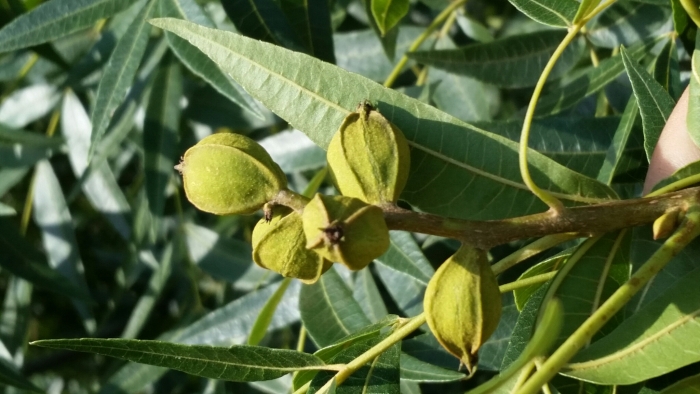Water Hickory
(Carya aquatica)
Water Hickory (Carya aquatica)
/
/

Jay Horn
CC BY 4.0
Image By:
Jay Horn
Recorded By:
Copyright:
CC BY 4.0
Copyright Notice:
Photo by: Jay Horn | License Type: CC BY 4.0 | License URL: http://creativecommons.org/licenses/by/4.0/ | Rights Holder: Jay Horn | Publisher: iNaturalist | Date Created: 2021-05-21T17:40:54-07:00 |



















































Estimated Native Range
Summary
Carya aquatica, commonly known as Water Hickory, is a deciduous tree native to the wetlands, river bottoms, and floodplains of the Southeastern USA. It is a member of the Juglandaceae family, which includes the walnuts and other hickories. Water Hickory can grow over 30 meters (98 ft) tall with a straight trunk and slender to moderately stout ascending branches. The bark is ridged and furrowed, and the tree is known for its pinnately compound leaves, which are late to emerge in the spring. Male and female flowers appear in April and May, with male flowers in catkins and female flowers in short spikes. The fruit is a nut with a thin husk and a bitter seed, maturing from October to December.
Water Hickory is valued for its adaptability to wet conditions and is often used in riparian plantings to stabilize stream banks and enhance wildlife habitat. Its wood is tough and flexible, making it suitable for tool handles and other equipment. In cultivation, it prefers full sun to part shade and can tolerate a range of soil drainage conditions, from slow to fast. While it is not commonly planted in urban settings due to its large size and preference for wet soils, it can be an excellent choice for naturalized areas or large landscapes. Water Hickory’s nuts are an important food source for wildlife, but they are not generally considered edible for humans due to their bitterness.CC BY-SA 4.0
Water Hickory is valued for its adaptability to wet conditions and is often used in riparian plantings to stabilize stream banks and enhance wildlife habitat. Its wood is tough and flexible, making it suitable for tool handles and other equipment. In cultivation, it prefers full sun to part shade and can tolerate a range of soil drainage conditions, from slow to fast. While it is not commonly planted in urban settings due to its large size and preference for wet soils, it can be an excellent choice for naturalized areas or large landscapes. Water Hickory’s nuts are an important food source for wildlife, but they are not generally considered edible for humans due to their bitterness.CC BY-SA 4.0
Plant Description
- Plant Type: Tree
- Height: 30-100 feet
- Width: 20-30 feet
- Growth Rate: Slow
- Flower Color: N/A
- Flowering Season: Spring
- Leaf Retention: Deciduous
Growth Requirements
- Sun: Full Sun, Part Shade
- Water: Medium
- Drainage: Slow, Medium, Fast
Common Uses
Bee Garden, Bird Garden, Butterfly Garden, Edible*Disclaimer: Easyscape's listed plant edibility is for informational use. Always verify the safety and proper identification of any plant before consumption., Water Garden
Natural Habitat
Native to wetlands, river bottoms, and floodplains in the Southeastern USA
Other Names
Common Names: Bitter Pecan, Swamp Hickory, Water Pignut, Bitter Water Hickory
Scientific Names: , Carya aquatica, Carya aquatica var. australis, Hicoria aquatica, Juglans aquatica, Hicorius aquatica, Hicorius aquatica var. australis, Hicorius aquaticus,
GBIF Accepted Name: Carya aquatica (F.Michx.) Nutt.